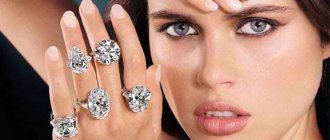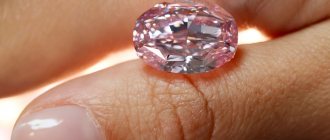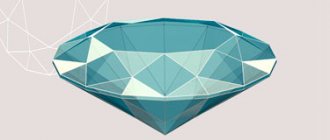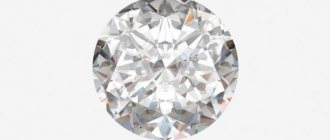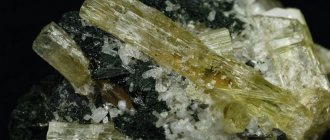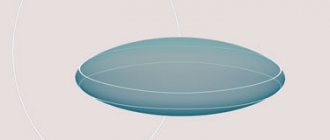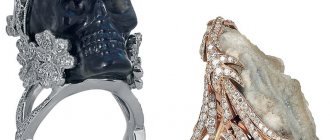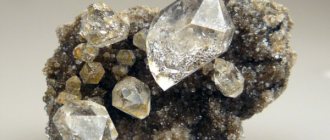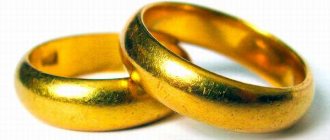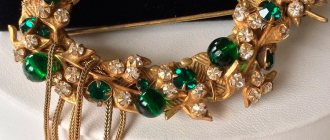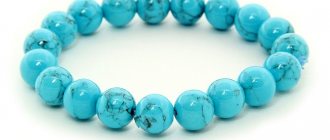History of the princess cut
Princess cut prototypes have been developed since the late 60s by Israeli lapidaries.
This processing method evolved from the French cut, which in turn evolved from the Table cut, which appeared in the 15th century. Discussions continue as to when and by whom the term and principles of Princess cut were first used. Some historians in the jewelry industry believe that in the 60s. In 1961, news was published that the Diamond Polishing Works had begun using a completely new cutting method developed by Arpad Nagy. This form of cut was originally called the “princess” cut, but later it became known as the profile cut.
One thing is for sure: by the 1980s, diamond lovers were enthusiastically embracing the “princess.” It became one of the very first mixed forms. Initially, the stone was cut using the “princess” method with 57 facets.
Quadrillion is a similar cut that had 49 facets and was developed in the early 70s. Somewhat later, the “princess” extended to this modification of the cut.
Diamond cut shapes
Round diamond shape
This is the most common diamond cut, and due to its 360 degree symmetry, the round diamond cut is the most optically attractive. If you want a sparkling diamond that will last for years to come, then a round cut diamond is just what you need. The round shape for cutting gemstones has been used for centuries, but in 1919 Marcel Tolkowsky managed to find such specific angles and proportions for cutting that the diamond he cut became the most brilliant in the world, and now it is this round shape that is the “ideal” cut in modern times. world. Round diamonds are the only shape in which it is possible to maintain those ideal proportions for cutting. Round diamonds pair well with almost any setting, be it a classic diamond ring or an avant-garde piece of jewelry. Round diamonds can be set with four or six prongs, depending on the design, or with a socket setting (a metal band around the facets of the diamond that holds the stone securely in the jewelry). In general, if a round diamond has an ideal or very good cut, you want the jewelry to have less metal around the stone itself, which would not cover the diamond itself or block light from entering the stone, and at the same time, you want it to be securely attached.
Princess cut diamond shape
The Princess cut is a modern classic with clean, square lines and beautiful sparkle. This shape is a great choice if you prefer square or rectangular shapes but want the same sparkle as a round diamond cut. Developed in the 1970s, the Princess cut is second in popularity only to the round cut. This form of stone cut combines the step cut of an emerald with the triangular cut of a diamond and is a square cut. Although a square cut shape is most preferred, some stones may have more of a rectangular outline. A princess cut stone looks beautiful either alone in a ring or framed by other stones, especially trillions and smaller diamonds cut in a princess shape. A very important detail here is to secure the most vulnerable corners with a V-shaped notch at each corner.
Escher diamond cut shape
This elegant shape, a variation of the classic emerald cut, was developed in 1902 by the venerable Escher brothers in Holland. Escher cut stone is not a traditional choice, however, it has gained deserved recognition due to being worn by celebrities. The uniqueness of this shape is defined by the pavilion or bottom portion of the diamond, which is a cut cut with all the edges gradually descending towards a corner or point on the bottom edge. The cut corners add to the attractive geometry of these diamonds, giving them an octagonal appearance. Typically, this cut has square contours rather than rectangular ones. This diamond cut looks beautiful in a simple diamond ring, in jewelry with simple geometric lines, or set with other stones such as baguettes. Ideally, the setting for an Escher cut diamond should not hide the unique cut corners.
Marquise diamond cut shape
The Marquise cut is a royal, elongated shape of the stone that tapers towards both ends. This cut shape adorns the finger, making it appear longer. When choosing a marquise cut shape, it is necessary to take into account the ratio of length and width. A 2:1 ratio is usually preferred, meaning that the length of the stone should be twice its width. However, like all fancy stone cuts, personal preference also comes into play here, and some may opt for shorter, wider shapes, while others will prefer longer, thinner shapes. Whatever your preference, making sure there is good symmetry is important for maintaining overall beauty. This cut shape is good both for a diamond ring and for jewelry in combination with other stones, especially baguettes and trillions. A Marquise-cut diamond must be reinforced with six prongs: four on the sides to securely hold the stone itself and two V-shaped prongs on each end, which are the most vulnerable parts of the diamond.
Diamond cut shape "Emerald"
A diamond cut into an Emerald shape stands among the classic forms of stone cutting. Its clean lines are obtained from step cuts or parallel facets. With this cut, the stone is usually given a rectangular shape, although more square contours of the diamond are possible, but the corners are always cut off. Due to the simple structure of the facets, sometimes inclusions are clearly visible to the naked eye, so diamonds cut in this shape should have good clarity (stones with clarity I1 and I2 should be excluded). When choosing an emerald cut, it is necessary to determine in advance the ratio of length and width: usually a ratio of 1.50:1.00 is preferred, which means that the length should be one and a half times the width of the stone. However, like all fancy stone cuts, personal preference also comes into play here, some may like the square contours of the diamond, while others may prefer the longer, thinner rectangular shape of the stone. The emerald cut is especially favored by purists. A stone cut in this shape looks good in platinum, either alone in a ring or framed by other stones in the shape of baguettes.
Diamond cut: Radiant (shiny)
The radiant cut is a wonderful combination of the classic emerald cut and the sparkle of a round brilliant. A radiant cut stone is very similar to a princess cut stone, but usually (though not always) has more rectangular contours and cut corners, like an emerald cut. This cut is a combination of step cut emeralds and triangular cut diamonds. Radiant looks stunning in a diamond ring, but also pairs well with other baguette, trillion or princess cut stones. A radiant-cut gemstone must be securely fastened into the jewelry using special prongs to hold the cut corners.
Cushion diamond cut
The cushion cut is an unusual form of diamond cutting and is an interesting alternative to oval or princess cut diamonds. Due to their rarity, diamonds of this shape are the choice of people who want to own a single item. The modern cushion cut is based on the antique cushion cut, which was a combination of round and square contours with a softened square or "cushion" shape. A cushion-cut diamond can be either square with equal proportions in length and width, or slightly elongated, depending on the stone itself and the preferences of its wearer. This cut looks great in a diamond ring, but also works great with other stones, such as baguettes. A cushion-shaped diamond must have at least four prongs to fit securely into the setting.
Diamond cut "Pear"
The pear cut is a beautiful, feminine cut of a diamond with a rounded end on one side and a tapering point on the other. This is a favorite shape for both a center stone in a ring and a pendant or drop earrings. As is the case with many other forms of cutting, you need to think about the ratio of length and width. Typically, a ratio of 1.5:1.0 is preferred, in the sense that the length of the stone is one and a half times the width. However, some people prefer either shorter and wider contours, or elongated and thinner shapes. Pear-shaped diamonds require good symmetry to ensure that light is reflected evenly, especially at the narrowing point. The asymmetrical shape should be taken into account when choosing a piece of jewelry in the form of a ring with a pear-shaped diamond or set with other stones, especially if they are the same pear-shaped or baguette-shaped, but smaller. A pear-shaped diamond must be mounted in a special setting with five prongs: two of which are attached at the rounded end, two on the sides to securely hold the stone itself, and one V-shaped prong at the point of narrowing at the other end, which is the most vulnerable part of the diamond.
Diamond cut shape "Oval"
The oval cut is most similar to the round cut diamond, combining the brilliance of a round cut with the elongated contours of a stone. This is a great choice for those who want a uniquely shaped gemstone but love the fire and sparkle of a round diamond. The ratio of length to width mainly comes from personal preference. Typically, preference is given to a ratio of 1.5:1.0, which means that the length of the stone is one and a half times greater than the width. However, as with all cutting shapes, your choice should be based on your personal wishes; some may prefer shorter and wider contours, while others may prefer longer and thinner shapes. The relative symmetry of the shape allows oval-cut stones to be used in a variety of jewelry styles. Oval diamonds look great in all the same types of jewelry as round diamonds. Like round cut stones, this too uses a setting with six prongs placed properly around the perimeter of the diamond to hold it securely.
Diamond cut "Heart"
A heart-shaped diamond is the most romantic form of gemstone cutting. This cut shape is very similar to the pear cut, only in this case the diamond has a cleft at the rounded end that forms heart lobes. Due to the complexity of this shape, skillful cutting is required to give the stone the proper shine. Symmetry is a very important point in this case, since the contours should have a nice obvious heart shape. The lobules should be rounded (and not with edges converging at points) and clearly defined. Heart-shaped diamonds should be set in special settings using five prongs: two on the heart lobes, two on the sides of the heart and one V-shaped prong at the tapered end to protect the most vulnerable part of the stone. The heart-shaped diamond is the most romantic cut shape. precious stones. This cut shape is very similar to the pear cut, only in this case the diamond has a cleft at the rounded end that forms heart lobes. Due to the complexity of this shape, skillful cutting is required to give the stone the proper shine. Symmetry is a very important point in this case, since the contours should have a nice obvious heart shape. The lobules should be rounded (and not with edges converging at points) and clearly defined. Heart-shaped diamonds should be set in special settings using five prongs: two on the heart lobes, two on the sides of the heart, and one V-shaped prong on the tapered end to protect the most vulnerable part of the stone.
Trillion diamond cut
The trillion cut is a striking cut that boldly makes a statement. This cut was developed in the 1970s as a variation of the radiant cut. It combines step cutting and diamond cutting. While a frequently used cut for setting stones, this cut is rarely used for centerpiece diamonds, so larger trillion-size stones are rarely found. The triangular shape requires special consideration in the style of the jewelry, and stones of this cut will probably look best in single-stone rings or uniquely shaped geometric jewelry. Trillion cut stones require a special setting that has V-shaped prongs to securely hold the corners of the diamonds.
Princess cut principle
The fancy princess cut has become the second most popular diamond shape. This is a wedge cut that combines elements of step and round brilliant cuts. The design is often referred to as square, but technically this is not entirely true. In reality, the “princess” follows the shape of an octahedron.
A stone cut in this way has sharp corners and a deep pavilion ends in a spike, making the specimen look like a pyramid. Most of the weight of the “princess” is concentrated in the pavilion, so the play of light comes from the depths of the stone.
The main advantage of this processing method is that the loss of the original mass is extremely small - about 80% of the mineral can be preserved. This results in a lower cost of production per carat and a lower cost to the end customer.
The cut has several varieties: “bugvillion”, “quadrillion” and “nissen”.
"Princess" and its analogues
There are four types of square cut diamonds – radiant, asscher, emerald and princess. To a person who does not really delve into the types of cuts, these varieties of square cuts will seem the same. If you look at a square diamond from above, you can see with the naked eye that all its faces are the same.
The radiant cut has greater depth compared to the princess cut. Although this cut is a square cut, it has rounded edges, which allows it to reflect light in a special way. This property makes the diamond more brilliant. The quality of color retention allows the diamond to exhibit a linear pattern of light.
Emerald and Asscher cuts also have linear facets, which add sparkle to the diamond. For such a cut, depth is not important, as, for example, for a “princess” cut. The “emerald” cut perfectly conveys color, so for products made from any type of precious metals it is best to choose the H range color range. Any product with an “emerald” cut will have a yellowish tint. The Asscher cut has a low level of brilliance, making it unable to hide external imperfections.
The cushion cut has the most similar properties to the princess cut. There is only a visual difference between them. If you look at the cushion from above, such a diamond will look more like a pillow with round edges than a square.
Processing Features
When projected onto the plane of the girdle, Princess cut has the shape of a square, less often a rectangle. When looking at a princess cut stone, it is difficult to understand how many facets it has. In the classic version, the following options are possible:
- 49 faces (two chevrons);
- 57 faces (three chevrons);
- 65 faces (four chevrons).
The crown, the top part of the stone, can have 25 facets or 33 facets. The number of sides of the pavilion, that is, the lower part of the stone, depending on the number of chevrons, can vary from 24 to 40 pieces.
Size and cut
The two types of cuts are similar in that both were designed to add more sparkle to a diamond. The huge difference between diamonds of different cuts is the number of facets. A round diamond has 58 facets. As for the “princess,” the number of facets of such a diamond may vary, although initially the number of facets was 58.
As for the visual difference, if you look at both diamonds from above, the round one will look significantly larger compared to the “princess” one, even with the same carat weight.
Jewelry examples
Stones of this cut are most often used to set engagement and wedding rings. For a diamond, the princess cut is the second most popular cut after the classic round shape. Tennis bracelets are often encrusted with Princess cut stones.
Engagement rings with a stone of this cut have graced the fingers of many celebrities, such as Sarah Michelle Gellar, Hilary Duff, Jaime Pressly and others. The photo below demonstrates the beauty of the princess cut diamond ring of Hilary Duff.
Shine and color
As stated earlier, both cuts are designed to add more sparkle to the diamond. However, according to diamond lovers, the round has a slight advantage over the princess. A round diamond has more fire due to the number of facets, so jewelry with such a diamond looks more vibrant.
As for color, the “princess” shows colors more easily. If a princess cut diamond will be set in a platinum or white gold piece, it is best to choose a GHI color diamond. For yellow gold items, the “princess” JK color scheme is perfect.
A round diamond has more facets, which prevents it from showing much color. For platinum and white gold items, choose a round diamond in the HIJ color range. The KLM color range is perfect for yellow gold items.
Purity.
The proportions and symmetry of the princess cut allow it to shine and sparkle enough to hide the visible inclusions of the stone. Only round diamonds sparkle and shine better than this.
It's worth noting that clarity lower than SI1 is rare for this cut. Therefore, such diamonds must be of VS1, VS2 and SI1 grades of clarity. It is in this range that you need to choose stones with a minimum number of inclusions.
Make sure that possible defects are not located at the edges and corners of the stone structure, otherwise they may lead to sharp corners breaking off.
Quality control.
When it comes to assessing the quality of a cut, there is no consensus on what proportions it should have.
When purchasing a princess diamond, the certificate will not include an overall assessment of the quality of the stone. The only thing that can be specified is the level of brilliance and symmetry of the diamond.
It is best to choose a cut of quality higher than “good”. A stone of this grade must have a total depth of 70% of the width.
If you look at the stone from above, it should be square. If its shape is rectangular, then it is valued less.
